Liquid cooling brakes. System development options
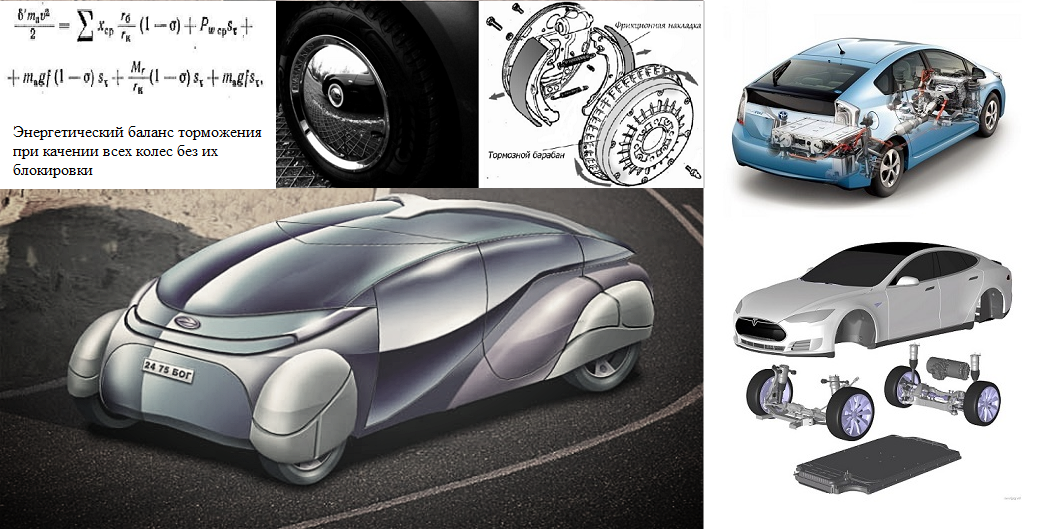

In the last article on the fluid brake cooling system, I described the current situation to date. If we consider this system within the framework of the classic internal combustion engine, then the development here is very limited, but with the advent of additional braking power in the car - recovery in hybrids and electric vehicles, the situation may change.
Recovery performs the bulk of the brake operation at low to medium loads. It is no secret that the resource of brake pads on electric vehicles is almost twice as high under the service regulations.
It would seem, why then electric vehicle liquid cooling? This is overweight and risk of fluid leakage! Such shortcomings, in general, and determined the fate of this system in the past for mass production of cars, but in the case of an electric vehicle - a hybrid, additional factors appear.
The first, and probably the main one , is the possibility of obtaining heat during braking and using it to heat the passenger compartment (without its useless dissipation into the environment).
This of course does not solve the problem of heating the cabin completely, but will reduce the cost of energy from the main power source. Even on hybrid cars, the possibility of obtaining additional heat will make it possible to save fuel. In the intermittent mode of operation, hybrid motors have time to "cool down" during the operation of the electric motor - as a result, additional fuel is spent to achieve the operating temperature.
In BMW, it is not by chance that they use more and more sophisticated ways of preserving engine heat, and behind adjustable “curtains” of front air intakes, coatings will soon follow, turning the engine into a kind of thermos. Reducing engine displacement shifts the problem from “how to cool an engine?” To “how to keep warm?”.
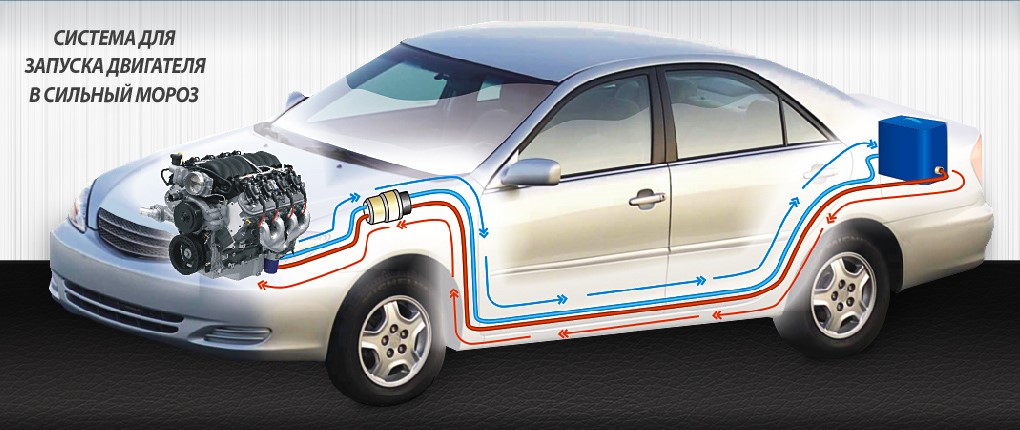
A promising option for energy conservation - heat accumulators. The problem here is mainly in the power consumption of the drive and its mass. If there is an additional source of energy for “charging” this battery, the range of use of such devices can be extended.
In an electric car, such a heat accumulator is more necessary than in a hybrid, and most importantly, the place for placement in an electric car is more than in a hybrid.
The front trunk is well suited to accommodate the thermal "thermos". Such placement will have additional advantages, which we will discuss further.
The second factor is absolutely the opposite - the use of heating when parking (when connected to the network) brakes, to reduce energy costs at the beginning of the movement. First of all, to maintain the optimum temperature of wheel bearings in the wheels. Along the way, this will solve the problem of freezing pads on some machines.
PHEV hybrids now allow you to warm the car when connected to the network. To heat the interior is nice, but warming up the insides of the suspension and transmissions will be an even better solution for the reliability and durability of the car.
Remember how often in the recommendations of the beginning of the movement in freezing weather they say about "warming up the suspension elements"? Hybrids have the ability to heat the suspension, but in the electric car there is no such source in principle. It is logical now to assume that the failure of the suspension in the winter on an electric car is not always the merit of poor-quality components and the "syndrome of the owner of an electric car"?
The third factor is the possibility of using drum brakes in a car. This will remove the excess friction of the pads on the brake disc, as there is always a gap in the drum brakes between the brake surface and the pad. Ecology abrasion pads will also be at a height, since the products of abrasion can be partially captured in the drum itself, which is basically impossible in disc brakes.
Probably many thought that I was too nagging in the issue of ecology? Pads affect the environment, and tires?
Here the answer will be simple - tires are the inevitable “evil”, without which movement is impossible in principle. Working conditions are different, as is the result. Although here it is necessary to recognize that the composition of many tires has already pretty "turned green" (which really affected their durability).
Those. the abrasion temperature of the pads on the disc simply leaves no chances for the formation of “environmentally friendly” components, even if they are “green” (not made on the basis of asbestos).
Another useful feature when using drum brakes is the preservation of thermal energy inside the drum. The main disadvantage will be an advantage for the fluid system. By and large, “liquid cooling” on disc brakes in cars from the previous article is not completely liquid. Rather, it is an additional cooling factor for a well-blown brake disc. In the case of drum brakes, the cooling process will be more “fluid”.
The fourth factor - in the presence of drum brakes is the “ideal” aerodynamics of the disc. There is no need to ventilate the brakes - you can close the wheel with a full heat insulating cap! “Excess heat” in this case is not at all superfluous for a liquid cooling system — heating.
An additional factor in facilitating such disks will be the lack of need to calculate the ventilation holes in the wheel, which are points of reduced strength, and because of this, have an impact on the final weight of the product.
A monolithic wheel is always stronger than a “leaky” one; therefore, it can be made of less durable materials, with a similar margin of structural rigidity. In this case, I hint at various types of carbon fiber composites and composites (these are already in our time, but the load on the wheel does not allow making them cheap enough because of the complex shape in production).
The fifth factor is the use of thermoelements. Since heat creates a significant temperature difference, it is possible to slowly but surely reclaim some of the energy by converting heat into electricity.
A simple example of how a thermogenerator works
While in practice, the use of temperature differences has been tested by BMW.
For the test, a thermoelectric generator based on bismuth telluride was placed near the exhaust pipe, which converts the temperature difference between the coolant and exhaust gases into a current. With dimensions of 300x100 mm, it produces about 600 watts. The lack of truth in the necessary conditions for such power - the speed of 60 km / h (below, due to the fall in temperature, the output is almost zero).
Conversion of heat into electricity can also be produced without such high temperatures. For example using steam and cold water.
Sixth factor- the use of a “heat pump” based on the heat recovery of the brake cooling system. This will solve the problem of restrictions on the outdoor temperature during operation (in Nissan Leaf electric vehicles, as on many frost-proof air conditioners, the system automatically shuts off when the temperature is below-zero below the temperature).
Seventh factor- the solution to the problem of recovery with a full battery electric vehicle, through the use of this energy for heating the cabin, front trunk, etc. Since the process with an excess of braking energy will follow the “long” energy conversion scheme, we will end up with a lesser load on the braking system, and a more controlled heat flow. This use case is needed for descent from the mountains, where the amount of energy from braking will exceed the needs of the car. Now sometimes they even put on special machinery a special mountain brake, in addition to the usual brake system and handbrake, so this will solve not only the heat problem, but also the brake one.
And now we will collect everything described together.
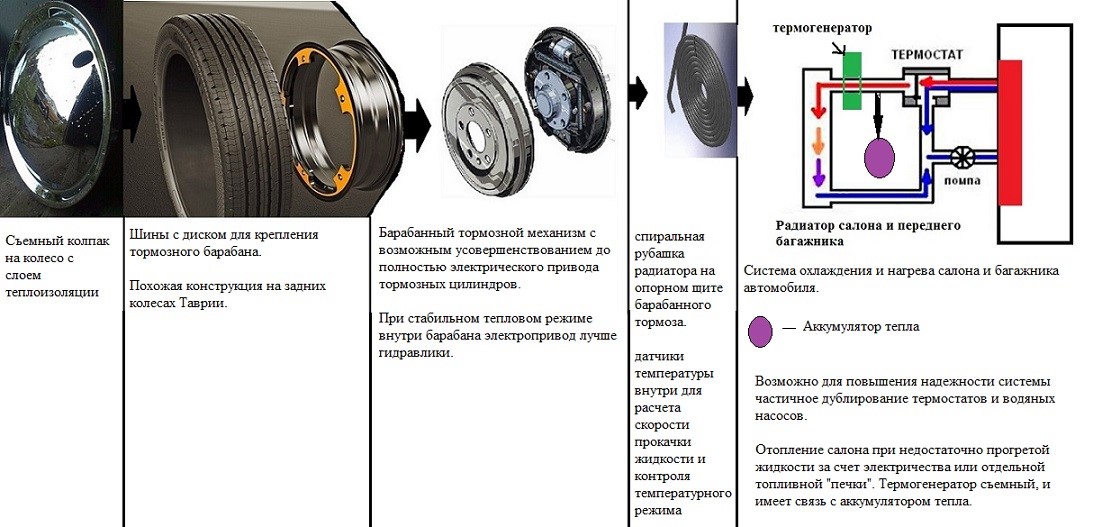
The resulting construction looks more complicated than usual, but I don’t see any other option to return the lost energy. Until 100% energy recovery is achieved, this option will be relevant.
Partially, you can also solve the problem of increased wheel mass, due to the repetition of the design of the brakes Citroen 2CV and Alfa Romeo 75 - 90.
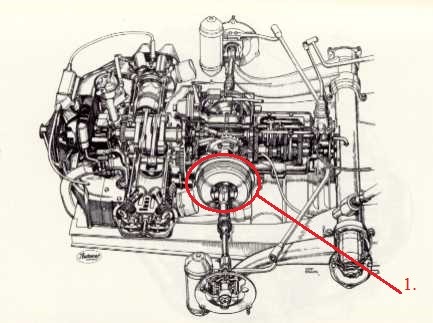
The "Frenchman" did not have brakes in the hub.
In 2CV, the front brakes (1.) were located on the crankcase, to the semi-axes, which reduced the unsprung mass and made the course smoother.
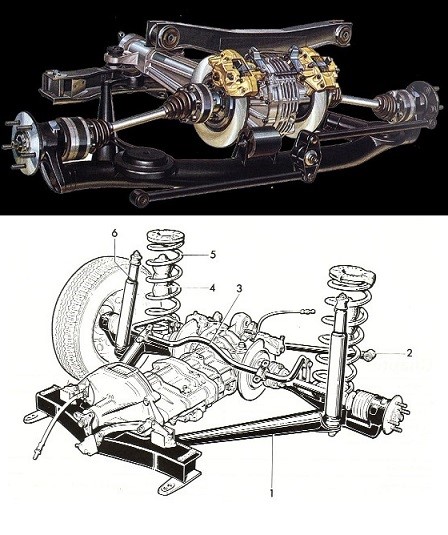
The same scheme, only in a limited rear-wheel version, was used on the Alfa Romeo 75 - 90.
Therefore, it is possible for the rear wheels to not install a cooling system in the hub ...
At first glance, additional cooling system pipes will only increase the number of hydraulic drives, but output options are also possible here.
For braking in the parking lot, the handbrake is already used in some car models by electric drive.
For the future, it is possible to use an electronic wedge brake (Electronic Wedge Brake).
This brake mechanism was developed in the German aerospace center, and further developed in Siemens VDO. The design of the brake has the ability to self-enhance during operation, and is capable of operating at standard voltage in the car (12 volts).
Structurally, these brake mechanisms are adapted for use on disc brakes, but the principle of self-reinforcement is in some drum mechanisms.
Therefore, it is quite possible to create an electronic drum brake, provided that the temperature is stable inside the drum.
PS - The consequences of lowering the maximum temperature in the wheel can have an impact on other suspension elements.
Only registered users can participate in the survey. Sign in , please.
